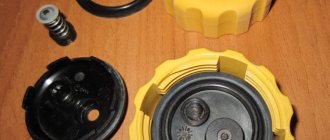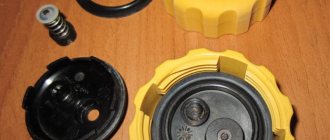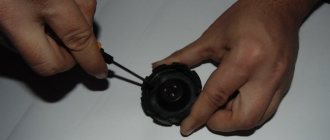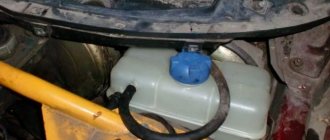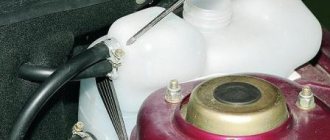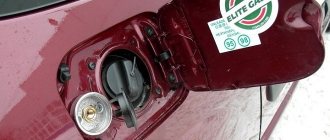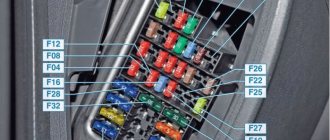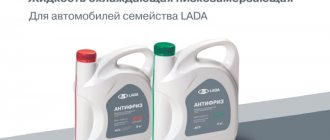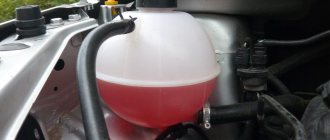Refining the expansion tank cap on Kalina will help improve the cooling system. It is no secret that the normal functioning of the main components of the car depends on proper engine cooling. If the tank element in question does not perform its function correctly, pressure interruptions occur in the cooling system.
Due to untimely bleeding of excess air, the pipes begin to leak. The hotter the power unit heats up, the higher the coolant temperature. Excess pressure from the sealed unit must exit through the expansion block and two-way valve.
After the system cools down, a similar process occurs, only with air being sucked inside. The tank cap should be periodically checked for scale, other formations and valve operation. If there is an excessive amount of various contaminants, the valve is deformed, does not perform its function and the system depressurizes.
Squeezes antifreeze out of the expansion tank
When operating a car with a cooling system, problems sometimes arise that are of various types. One of these is squeezing out the coolant from the expansion tank. There can be many reasons for this phenomenon. Therefore, it is worth dwelling on each of them separately, considering the signs of manifestation and the consequences of untimely repairs.
Cylinder head gasket burnout
The most common problem in which antifreeze is expelled from the expansion tank is the burnout of the gasket between the engine block and the head. The seal can be damaged for various reasons, for example, when the engine overheats. You can determine that a breakdown is caused by a loss of tightness as follows:
- Start the engine and open the reservoir cap.
- If air bubbles come from the main hose when idling, this clearly indicates a problem with the gasket.
Gasket breakdown can be different:
- if the seal is damaged internally, white smoke will be observed from the exhaust pipe;
- if the outer part of the gasket is damaged, the antifreeze will be squeezed out, which cannot be missed by the smudges on the cylinder block.
The second option is a rather rare case. Most often, it is the inner part of the seal that is damaged, and coolant gets inside the cylinder. A gasket failure can lead to serious consequences, namely overheating and engine jamming, as well as water hammer of the cylinder head and the appearance of cracks in the unit housing.
Video: reasons for squeezing antifreeze into the expansion tank
Airing the system
Often, when replacing coolant or depressurizing the system, an air plug is formed, which is an air bubble. As a result, the stove may not work, the engine may overheat, and antifreeze may leave the expansion tank.
You can make sure that the problem is caused by an air lock by applying gas, that is, letting the engine run at high speeds. If bubbles appear in the expansion tank and the liquid level decreases, then most likely the air plug is broken.
Expansion tank malfunctions
There are cases when the coolant leaves directly from the expansion tank, and leaks can be observed on its body or under it. If the tank is located between body elements and a crack has formed in its lower part, then the part will have to be dismantled to identify the leak. The reasons for coolant squeezing out may be the following:
- the tank lid does not close the neck tightly, and the liquid splashes out under pressure during operation of the power unit;
- there are problems with the bypass valve located in the plug;
- A low quality expansion tank is used, which has led to cracks.
The design of the tank is made in such a way that a safety valve is built into the plug, through which excess pressure that occurs in the system during heating of the antifreeze is released. If the valve begins to malfunction, then under the influence of high pressure the coolant will come out through one of the weak points: the joints of the pipes, the threads of the plug.
If we consider VAZ cars of the “tenth” series as an example, then due to problems with the valve on these cars the expansion tank ruptures. In this case, the leak cannot be ignored, since antifreeze will escape in large quantities through the resulting hole, which will also be accompanied by the formation of copious amounts of steam from under the hood.
Pipe defects
As rubber ages over time, the cooling system pipes will sooner or later crack and fail. Antifreeze leakage can be detected when the engine is warm, as the pressure in the system increases. To identify a damaged hose, it is enough to conduct a thorough inspection of each of them. They also probe with their hands the connections between the pipes and the fittings of the radiator, cylinder head, etc.
If a hose leak was not detected, but there is a clear smell of antifreeze in the passenger compartment or engine compartment, this indicates a coolant leak, liquid entering the exhaust system and its subsequent evaporation.
Coolant leak
Often the problem of coolant escaping into the expansion tank is caused by a low level of antifreeze in the system. As a result, rapid heating of the fluid and the motor occurs, followed by overheating. This leads to evaporation of antifreeze and increased pressure in the system. In such a situation, the coolant is constantly distilled into the expansion tank, regardless of the operating mode of the power unit. If the antifreeze level remains the same after the power plant has cooled, this indicates problems with circulation. If the level drops below the MIN mark, this will indicate a loss of system tightness. If there is a leak, you need to identify the cause and fix the breakdown.
Radiator problems
The antifreeze in the cooling system tank may also decrease due to damage to the main radiator. The most common malfunctions of this device are:
- mechanical damage to the radiator honeycomb, for example, when hit by a stone thrown from under the wheels;
- wear of the radiator honeycomb as a result of corrosion;
- long-term operation also leads to breakage of the side plastic radiator tanks.
To detect a radiator leak, you do not need to disassemble anything: the problem should be clearly visible, especially if the tanks are damaged.
Pump damage
If a puddle of antifreeze was found under the car at the location of the pump, then troubleshooting should start with this mechanism. However, it is worth considering that the engine compartment and some components on different cars are protected by casings, and the coolant can leak in one place, and the source of the leak is located in another. A leak from the water pump can be caused by the following problems:
- lip seal wear;
- Damage to the gasket between the pump and the cylinder block.
To more accurately determine the cause of the leak, just reach with your hand to the pump pulley and feel the space under the shaft. If drops of coolant are detected, this will indicate a seal failure. However, this method of checking is applicable only to cars on which the pump rotates from the alternator belt. If the shaft is dry and the cylinder block near the pump is wet, then most likely the problem lies in the seal.
Lada Kalina vs Lada Granta
So is there a difference between Kalina and Granta? Undoubtedly. This difference can be explained by the fact that AvtoVAZ engineers, when designing Lada Grants, pursued the goal of introducing all the best from Kalina into the new product, eliminating all the shortcomings and making it cheaper. And so it happened, the base Lada Grant car came off the assembly line at a price 50,000 rubles less than its “colleague” Kalina.
The platform on which the new product is mounted has also been slightly modified. The body structure has increased rigidity up to 12.
The updated rack, which is equipped for the entire model range (except for the basic version), rotates 3.1 turns all the way, while for Kalina this parameter is 4.02 turns.
Better grant management. To achieve this, it was decided to install more powerful anti-roll bars. The inclination of the front suspension strut is the same as that of the motorcycle fork - 2 ° 25 ', the camber of the rear wheel is 1 ° (similar to the characteristics of the Mazda 3), positive toe-in is 10 minutes.
The Grants light block is simpler than its partner. The new product uses H4 type lamps, when the more expensive H7 ones are installed in the Lada Kalina. In addition, in the new product the radiator grille and bumper are made as a single element, while in the Kalina model they are two separate elements, which increases the cost of assembling the car. Along with this, the new product contains a number of other design changes, as a result of which the number of elements of the front part is reduced.
Lada Granta car paint is produced using modern equipment from Germany PPG Helios. The AvtoVAZ company bought it specifically to paint a new car. With the help of this equipment, the car's paint protects it from corrosion with the possibility of long-term preservation of the original color.
As for the Lada Kalina, its main drawback is considered to be the excessive noise of the power unit. As Grants users say, in a new car, even at high speed, you can communicate under your breath.
Troubleshooting Methods
Depending on the breakdown, the nature of the repair will differ. If the problem is caused by coolant leakage, then this can be identified, for example, by leaking pipes. Fluid emissions will also be clearly visible in the form of colored streaks on the expansion tank near the plug. In the event of minor damage to the radiator, finding the location of the leak will not be so easy, since the device is blown by a counter flow of air and leaks cannot always be detected.
To simplify the leak detection procedure, it is recommended to fill the system with coolant with a fluorescent additive. Using an ultraviolet lamp you can easily detect the slightest smudges.
Any malfunctions that occur can be resolved as follows:
- If problems arise with the expansion tank plug valve, you can try to clean and rinse it. No results will indicate the need to replace the part.
- If cracks appear on the tank, it will have to be replaced. Sometimes the expansion tank is restored by soldering, but this option is unreliable, since with the next pressure surge the housing may burst again.
Video: how to get rid of air in the cooling system
If any malfunction occurs on the road, you can add antifreeze or, in extreme cases, water and get to the nearest car service center. The exception is a blown head gasket. In case of such a breakdown, you must call a tow truck to transport the car.
Most of the problems that cause coolant to squeeze out of the expansion tank can be fixed on your own. To replace pipes or pumps, you do not need special tools or skills. Repairing more serious damage, such as replacing the cylinder head gasket, will require certain skills, but this procedure can also be performed in a garage without specialized equipment.
Theme Options
Search by topic
Tools
The following tools will be needed for work:
- Set of keys (including wrench, extension and sockets);
- Container for draining coolant;
- Hose;
- Syringe;
- Double sided tape.
As for the tank itself, it is recommended to buy a product of a new design - this is a reinforced tank, which can be purchased under article number 11180-1311010-10. Its price is low and does not exceed 300 rubles.
Pressures antifreeze through the expansion valve
Hello! Antifreeze presses through the expansion tank and does not return. I ordered a new plug while I placed it under the old wire. When antifreeze is poured from the expansion tank into the radiator, bubbles appear at first, then at any speed there are no bubbles. When the fans are turned on, the antifreeze level in the expansion chamber drops approximately 1 cm from the cap to the minimum mark. Do you think it will cost you to replace the plug or prepare to replace the head gaskets?
It’s unlikely that there are cylinder head gaskets, but at rpm there are no bubbles
But where does the air in the system come from when the plug valve is open? The expansion volume is not enough. Sometimes you have to add water.
Maybe your thermostat just isn't opening? If the antifreeze is thrown through the expander, and the lower radiator hose is cold, then for sure.
The lower pipe and pipes to the stove are hot. There is sometimes a smell of antifreeze in the cabin when the heater is on.
how do you top it up? back to start gradually or topped up, closed, turned on the throttle, opened again, topped up?
air may still enter the system when the coolant cools, if the tube in the expansion tank does not fit tightly, it will suck in air instead of coolant, or from under the radiator cap, if the rubber sealing the boat there has become damaged
refilled, closed, re-opened, refilled. car facing up.
Topped it up, closed it, turned it off again, topped it up again. The car is facing up.
The tube fits tightly; with the jammed lid, the current was pressing through the expansion valve. The area around the radiator cap is dry.
If the cap is jammed, it will not press into the expansion chamber, but will rupture the radiator or pipes. I agree with the post above, look at the thermostat
water went into the expansion chamber, but was not sucked back in. with the wire attached (the valve is open), there is no pressure in the system, but it is sucked back into the radiator.
Is the bottom pipe hot? my (now former) Legaska with the same engine has been riding with wire for almost 2 years
Yes, the bottom pipe is hot. It is not clear why, with a wire, when warming up, the water level in the expansion chamber rises from min. almost to the brim. I'm afraid that there is pressure through the cylinder head gasket, or there is air in the system.
when the fans are turned on it drops back to minimum
Tribeca with the same symptoms. Replaced the cover of the thermostat and pump - the problem was not solved. Although it’s not a fact that the cause is the same, the symptoms are very good. similar.
The owner is going to change the cylinder head gaskets, but I don’t think it will help
miracles do not happen, it means there is air in the system, only it can squeeze out coolant. Jack up the face of the car when it is cold and add coolant. then start and let the engine run for 3 minutes, then some more
Your expansion tank is clean inside. There is no oily residue. What a smell. Doesn't look like exhaust.
If, when cooling the engine, the system does not take coolant from the expansion chamber, then you need to look for air leaks and the reason for this could most likely be the cylinder head gaskets; you can visually determine if there are hints of leaks on the gasket. On mine I cured such a problem by replacing the gaskets, and also did not remove the fluid from the expansion valve. And in order to expel air from the system, you need to put the wheelbarrow with its face in the air, I will say that these dances are a completely empty act if the cooling system is working, you just need to fill the radiator to full and the required level in the expansion tank, and then the engine will sort itself out.
Last edited by Karek; 06/17/2010 at 18:52.
The “health” of the engine cooling system is the key to reliable operation and longevity of the power unit. A sealed, fully operational system ensures coolant circulation, effective heat removal, and maintenance of normal engine temperature conditions. Problems can lead to overheating of the motor, leading to serious malfunctions, expensive repairs or complete replacement. One characteristic of most modern cars is the squeezing of antifreeze (antifreeze) through the expansion tank cap.
Improved cooling of VAZ-1118 “Kalina”
To reduce the likelihood of SOD aeration due to the jamming of the compensation valve of the expansion tank cover, readers suggested removing the valve from it as a temporary measure. We cannot recommend this method as it increases the risk of boiling and overheating of the engine.
A more correct update option has been repeatedly tested and shown to work on cars with a cable-operated throttle valve.
The problem of air removal is solved once and for all.
We wish our readers a warm interior and stable engine temperature!
A simple look at the problem.
The expansion tank plays an important role in the cooling system. Its main function is to dampen pressure fluctuations in pipelines that arise as a result of an increase (decrease) in the volume of antifreeze during heating (cooling). Thanks to the presence of such a container, mechanical loads on system elements are reduced, water hammer and the appearance of air locks are prevented.
In fact, the tank replenishes the lack of fluid in the lines during cooling and serves to receive excess fluid when heating. Structurally, it is made in the form of a plastic sealed container.
A mandatory part of the design is a safety valve for releasing excess pressure into the atmosphere.
When antifreeze heats up, it expands, filling the free space of the tank, and the evaporation rate increases. This leads to an increase in pressure in the volume. An increase in pressure above a threshold value triggers the built-in valve.
The only situation when antifreeze is thrown out of the expansion tank is when the valve fails to perform its assigned functions.
Causes of the phenomenon.
There are several groups of reasons why antifreeze is thrown out of the expansion tank.
Problems with the tank.
Despite the simplicity of the design of the expansion tank, it is often its malfunctions that cause problems with the release of antifreeze:
- Violation of tightness. Antifreezes are characterized by high fluidity rates; accordingly, even a microcrack in the walls of the vessel, indistinguishable to the naked eye, will lead to the squeezing out of the liquid, especially with increasing pressure. The main sign of a malfunction will be the appearance of a coolant stain under the car after a long period of parking. The best solution is to replace the tank. Do not forget that there is a significant amount of low-quality products on the market from little-known manufacturers offering thin-walled tanks made in violation of production technologies. A pre-installation check performed using a compressor will help you avoid problems in the future.
- Defective threaded connections. The tightness of the device largely depends on the quality of the threads on the neck and lid. Chips and burrs prevent the parts from fitting tightly. As a result, as the pressure increases, the coolant is knocked out through the formed microchannels. When replacing, you should pay attention to the quality of the neck and lid; a preliminary check is advisable.
- Valve fault. The lid valve is also a source of problems. A typical situation is that there are no problems at idle engine speed; as the speed increases and the load increases (while driving), the antifreeze literally knocks out from under the expansion tank cap. Disassembling the valve and then cleaning it often helps to resolve the problem. Otherwise, replacement is required (it is preferable to replace the entire cover).
Video about checking the expansion tank yourself.
Impaired coolant circulation.
The occurrence of problems with the circulation of antifreeze leads to significant overheating of the coolant, an explosive increase in pressure in the expansion tank and squeezing out through the cap.
The causes of the phenomenon are:
- Thermostat failure. The malfunction leads to fluid circulation in a small circle (the radiator, where cooling occurs in operating mode, is excluded). The situation is fraught with overheating of the engine and the cooling system fluid.
Video (how to determine a thermostat malfunction).
- Formation of air pockets in the radiator tubes or clogging of the channels with scale and/or mechanical particles. The radiator needs to be cleaned and flushed. An untimely detected problem will lead, as in the previous case, to serious malfunctions of the power unit.
- Failure of the water pump.
Antifreeze leak.
The most typical option is a lack of antifreeze circulating in the system. Reducing the amount of liquid leads to an increase in its temperature as the engine cools. Overheating promotes intense evaporation of antifreeze and a significant increase in pressure.
There is a constant transfer of antifreeze into the expansion tank, regardless of the mode and engine speed. If the level persists after cooling, it indicates a circulation problem. A decrease in the level to the minimum level (or below) indicates a violation of the tightness of the system.
In the latter case, the motorist’s task is to discover why the leak occurs, to identify parts and connections that require repair or replacement.
Video about finding fluid leaks.
The most common faults:
- Aging (wear) of pipes and hoses intended to connect components of the cooling system. Parts are exposed to constant exposure to liquid heated at high temperatures, which increases the intensity of the aging process. Among the most likely problem areas are the connecting hoses on the tank. As a temporary measure, installing additional clamps can help. The best solution is to replace worn parts.
- Cracks in the radiators of the cooling system, heater, air conditioner. Problems with the stove are indicated by the appearance of a characteristic smell of antifreeze in the cabin.
- Violation of the integrity of the seals of the pump and thermostat. Traces of liquid on the surfaces of nearby parts will help detect the problem unit.
- Burnout (breakthrough) of the cylinder head gasket. As a result, there is a danger of antifreeze entering the cylinders of the power unit and the lubrication system or mixing the liquid in the cooling system with the oils used for lubrication. Signs of a malfunction include white smoke from the car's exhaust pipe, steam from under the hood (if it breaks out), and the formation of an emulsion in the expansion tank and/or oil sump. The malfunction requires immediate intervention, since deterioration in the quality of the oil and coolant can lead to overheating of the power unit, accelerated wear of the crankshaft journals, problems with the camshaft, cylinder-piston groups, and engine seizure. The gasket needs replacing.
Video (broken cylinder head gasket, signs and consequences).
Complete diagram of the Lada Kalina engine cooling system
The cooling system of the Lada Kalina is one of the main elements of the car's design. Its design and layout are typical for all cars and are practically no different. The main purpose of this design is to ensure timely cooling of the main power unit and prevent its overheating.
